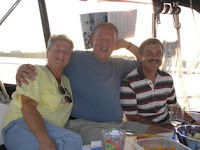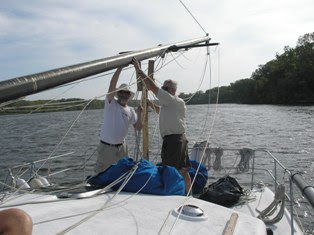


Our transit from Bohemia Bay to Annapolis was mostly a smooth motor and motor-sail.
We initially anchored in Spa Creek, right beside the Naval Academy. Moorings cost $25 per night. In many respects, the location could not be better. Your are right in the center of the tourist area of town. The second day we were there, however, they removed the dingy dock that was closest to us in order to do some major renovations to the waterfront. We wanted to visit with some friends (Recess and Joanne-Marie) who were anchored in nearby Weems Creek, so after 3 days, we moved.
One of the photos shows one of our neighbours in Spa Creek, the Winning Drive. Rumour had it that this is one of Greg Norman’s (the shark) boats, although far from his largest. The boat went to the gas dock next door one day. It took at least 4 hours to fill up! No wonder marina owners have little use for us sailboaters.
While we were in Spa Creek, I was able to fibreglass the decks where they had been damaged near Sandy Hook, strengthening them considerably in the process. I also chose to leave a bridle from the mast-head to the tail end of the davits permanently in place, removing much of the torsional load from the base of the davits and from the deck. When reparing the fibreglass, I noted that the aluminum davits had also started to crack at the base. I guess that the moral is not to leave the dingy on davits when in open waters, but always to hoist it onto deck. With a small and slippery dingy like the Walker Bay, this is not difficult, and we have room on the afterdeck, so it would be stupid to do otherwise.
When we were at Weems Creek, we proved that sometimes, it pays to be the poor neighbour. Our friends on Joanne-Marie had grown greatly frustrated with their Merc 3.5 and their Merc 9.9. The decided to buy a new Merc 6 (getting a good deal at Annapolis West Marine by combining their purchase with a purchase of 2 refrigerators by Recess). They gave us their old motors. We would use the little one on our new dingy and use the other on our Sirius 21, the Bud, back at home.
Now I am sorry we did not buy an inflatable, but how could we forsee that someone would give us an outboard motor: one of which needed only the starter cord to be replaced to become functional and the other of which probably needs the starter recoil mecnanism to be cleaned and lubricated.
The insult to injury was that within a day, our friends new motor quit working while their cast-off was now working fine. Actually, the dingy outboard motors on both Recess and Joanne-Marie quit working, so I think they may have jointly bought a bad batch of gas somewhere.
We initially anchored in Spa Creek, right beside the Naval Academy. Moorings cost $25 per night. In many respects, the location could not be better. Your are right in the center of the tourist area of town. The second day we were there, however, they removed the dingy dock that was closest to us in order to do some major renovations to the waterfront. We wanted to visit with some friends (Recess and Joanne-Marie) who were anchored in nearby Weems Creek, so after 3 days, we moved.
One of the photos shows one of our neighbours in Spa Creek, the Winning Drive. Rumour had it that this is one of Greg Norman’s (the shark) boats, although far from his largest. The boat went to the gas dock next door one day. It took at least 4 hours to fill up! No wonder marina owners have little use for us sailboaters.
While we were in Spa Creek, I was able to fibreglass the decks where they had been damaged near Sandy Hook, strengthening them considerably in the process. I also chose to leave a bridle from the mast-head to the tail end of the davits permanently in place, removing much of the torsional load from the base of the davits and from the deck. When reparing the fibreglass, I noted that the aluminum davits had also started to crack at the base. I guess that the moral is not to leave the dingy on davits when in open waters, but always to hoist it onto deck. With a small and slippery dingy like the Walker Bay, this is not difficult, and we have room on the afterdeck, so it would be stupid to do otherwise.
When we were at Weems Creek, we proved that sometimes, it pays to be the poor neighbour. Our friends on Joanne-Marie had grown greatly frustrated with their Merc 3.5 and their Merc 9.9. The decided to buy a new Merc 6 (getting a good deal at Annapolis West Marine by combining their purchase with a purchase of 2 refrigerators by Recess). They gave us their old motors. We would use the little one on our new dingy and use the other on our Sirius 21, the Bud, back at home.
Now I am sorry we did not buy an inflatable, but how could we forsee that someone would give us an outboard motor: one of which needed only the starter cord to be replaced to become functional and the other of which probably needs the starter recoil mecnanism to be cleaned and lubricated.
The insult to injury was that within a day, our friends new motor quit working while their cast-off was now working fine. Actually, the dingy outboard motors on both Recess and Joanne-Marie quit working, so I think they may have jointly bought a bad batch of gas somewhere.















































